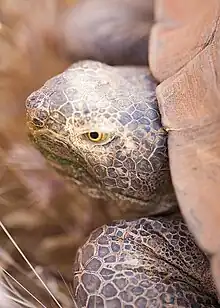| Gran Canaria giant tortoise Temporal range: Miocene-Pleistocene | |
|---|---|
| Scientific classification | |
| Domain: | Eukaryota |
| Kingdom: | Animalia |
| Phylum: | Chordata |
| Class: | Reptilia |
| Order: | Testudines |
| Suborder: | Cryptodira |
| Superfamily: | Testudinoidea |
| Family: | Testudinidae |
| Genus: | Centrochelys |
| Species: | †C. vulcanica |
| Binomial name | |
| †Centrochelys vulcanica (López-Jurado & Mateo, 1993) | |
| Synonyms | |
|
Geochelone vulcanica López-Jurado & Mateo, 1993 | |
The Gran Canaria giant tortoise[1] (Centrochelys vulcanica[2]) is an extinct species of cryptodire turtle in the family Testudinidae endemic to the island of Gran Canaria, in the Canary Islands.[3]
Characteristics
This is one of the two described species of giant tortoises that inhabited the Canary Islands from the Miocene to the upper Pleistocene. The other species is C. burchardi, from the island of Tenerife.[4][5]
C. vulcanica was described by López-Jurado & Mateo in 1993. It is believed that the ancestors of these two species of giant tortoises reached the Canary Islands from North Africa.[6] The majority of C. vulcanica fossils are of eggs and nests ranging in age from the Miocene until Pliocene. Bones and shells are known from the Miocene to the Upper Pleistocene. The maximum shell length is up to 61 centimeters, make it slightly smaller than C. burchardi, which had a shell length range of 65 to 94 cm.[7]
Fossilized tortoise eggs have been found in the islands of Lanzarote and Fuerteventura; however, these eggs have not yet been properly described or named.[8] The Fuerteventura fossils have been linked to C. burchardi, but this identification is uncertain, and has been challenged.[9][10]
See also
References
- ↑ "The Recently Extinct Plants and Animals Database Extinct Reptiles: Geochelone vulcanica". Archived from the original on 2016-06-24. Retrieved 2016-06-17.
- ↑ Anders G.J. Rhodin; Scott Thomson; Georgios L. Georgalis; Hans-Volker Karl; Igor G. Danilov; Akio Takahashi; Marcelo S. de la Fuente; Jason R. Bourque; Massimo Delfino; Roger Bour; John B. Iverson; H. Bradley Shaffer; Peter Paul van Dijk (2015). "Turtles and Tortoises of the World During the Rise and Global Spread of Humanity: First Checklist and Review of Extinct Pleistocene and Holocene Chelonians" (PDF). Chelonian Research Monographs. 5 (8): 000e.1–66. doi:10.3854/crm.5.000e.fossil.checklist.v1.2015.
- ↑ "La Paleontología de vertebrados en Canarias" (PDF). Archived from the original (PDF) on 2018-10-01. Retrieved 2016-06-17.
- ↑ "Fauna subfósil de las Islas Canarias" (PDF). Archived from the original (PDF) on 2020-12-31. Retrieved 2016-06-17.
- ↑ "La Paleontología de vertebrados en Canarias" (PDF). Archived from the original (PDF) on 2018-10-01. Retrieved 2016-06-17.
- ↑ El legado paleontológico de nuestras islas
- ↑ El legado paleontológico de nuestras islas
- ↑ "Fauna subfósil de las Islas Canarias" (PDF). Archived from the original (PDF) on 2020-12-31. Retrieved 2016-06-17.
- ↑ "New chelonian eggs from the Tertiary of Lanzarote of Fuerteventura" (PDF). Archived from the original (PDF) on 2016-06-19. Retrieved 2016-06-17.
- ↑ The Recently Extinct Plants and Animals Database Extinct Reptiles: Geochelone
